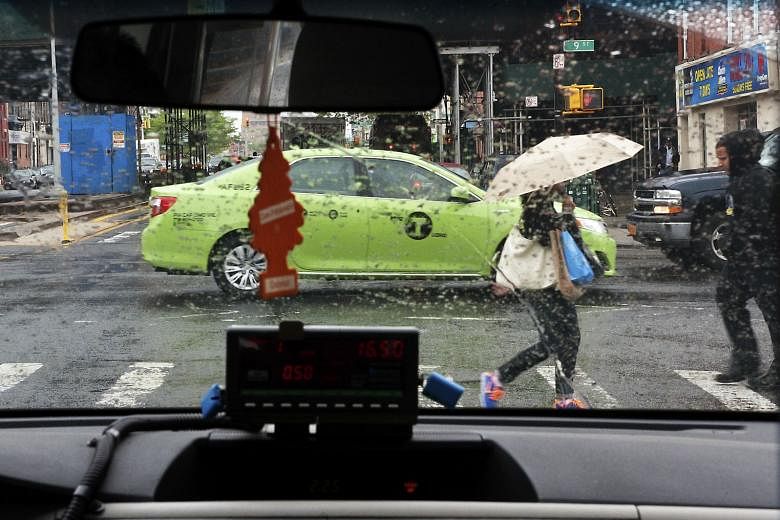NEW YORK • First, the drivers of yellow taxis saw red. Now those piloting green cabs are seeing red too.
Take for example the case of Mr Mohammed Uddin who was having a bad day, and it was only lunchtime.
He was fourth in line at a green-taxi stand in Astoria, Queens (one of the five boroughs in New York), and not happy about it.
But he was not waiting for a green cab to pull up. He was in a line of green cabs waiting for passengers outside the Astoria Boulevard subway station.
"I started at 9am," said Mr Uddin. "I made US$47 (S$65) so far. That's very bad. If Uber hadn't come in, it wouldn't be like this."
Uber and Lyft, the ride-share services that have transformed the way many New Yorkers get around, have plunged the yellow cab industry into an existential crisis.
But green-cab drivers are no less angry, saying Uber and Lyft have torpedoed their fledgling segment of the taxi industry before it even had a chance to establish itself.
Mayor Bill de Blasio recently signed a Bill into law that capped ride-share vehicles at their current level, around 100,000. But drivers like Mr Uddin said the cap was unlikely to create a new window of opportunity for green cabs, in part because ride-hail cars outnumber green taxis 30 to 1.
City officials estimate the number of green cabs to be around 3,500.
The city wanted green taxis to be an antidote to a longstanding problem: Yellow cabs rarely pick up people outside Manhattan, except at the airports.
But their arrival more or less coincided with the rise of Uber, which, after establishing itself in Manhattan, expanded across the city.
Uber counters that it helps green cabs because many green-taxi operators also drive for Uber.
An Uber spokesman said it dispatches more than 50,000 trips to green taxis every month.
But figures from the city's Taxi and Limousine Commission (TLC) underscore how much business for green cabs has declined since ride-share cars arrived.
In May, green taxis made 25,693 trips a day across the city, a 55 per cent decrease from May 2015, the busiest month on record, which had 57,637 trips.
For green cabs, revenue has declined proportionally as trips have dwindled, to US$386,965 a day citywide in May, from US$862,099 in May 2015.
As for whether Uber had hurt the green cabs, Uber spokesman Jason Post said: "I would say Uber has built a better mousetrap."
Green taxis were supposed to be that mousetrap - a new category for the entrenched taxi industry, created when Mr Michael Bloomberg was mayor. "The right to hail a legal taxi in all five boroughs," he said in 2013, was "something that New Yorkers have deserved and never had."
But some passengers said green cabs never fulfilled their promise.
"They filled a crucial void in areas like Harlem, where yellow cab service was spotty at best" when they first hit the streets, said Mr Derek Johnson, who lives in Harlem.
"But I think it's hard to dispute that the ride is better with Uber and Lyft and the reliability is more assured."
But that was not the only problem for green cabs. "The city was kind of undercutting them by licensing all those other cars" - the ride-share vehicles, said Mr Graham Hodges, a historian of the taxi industry and a professor at Colgate University.
"There are far too many vehicles on the road and that's where I think the TLC will tighten up regulation," he added. "And when they do, the ones with those permits will be in the best legal situation. They'll be the ones who survive."
NYTIMES

